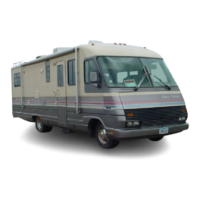Variable
Speed
Engine Fan
Your
motor
home engine
is
equipped with a variable
speed fan clutch. When the engine is under load or
re-
quires maximum cooling, the
fan
adjusts
and
tums
faster.
The fan may become very noisy at high
speed
and
when
maximum
cooling is required. When the engine doesn't
need maximum cooling, the fan
just
idles along. This
conserves fuel and the fan
is
less noisy.
High speed fan noise can sometimes be misinterpreted
as transmission
slippage. This is
not
the
case.
When
the
engine is hot
and
requires
extra
cooling, the fan tums
at
full speed. High engine speed and temperature con-
artions. such
as
pulling, away from a
stop'
after long
freeway driving,
cim cause loud fan noise until the engine
cools down. This fan noise indicates
that
the
fan is do-
ing
what
it
is supposed
to
do.
This noise is not a defect
in
the fan
or
the transmission.
ENGINE EXHAUST SYSTEM
COMPONENT
HEAT
Your
motor
home engina has been designed to con-
form
with
Federal and State emission requirements.
To
meet
these requirements, engine operating temperatures
are high.
As a result. the engine and exhaust system ,
components radiate a great deal
of
hllat. Parts of the
exhaust system may operate
at
temperatures near
700
degrees
F.
The temperatures
are
normal for your
vehicle.
Special heat shields may
be
built into your vehicle
to protect wiring or other components from possible
heat
damage caused by the exhaust system. Do not
modify
or remove these shields without consulting your
RV
dealer.
If
you
want
to
install equipment. add wiring,
plumbing.
or
other components near the exhaust system
or
the;,heat shields. do so only after you thoroughly in-
vestigate and understand
how
the equipment will
be
affected
by
the
heat radiated
by
the exhaust system.
CARBON MONOXIDE SAFETY PRECAUTIONS
Carbon monoxide is a colorless. tasteless. odorless
gas.
It
is
a by-product
of
combustion in engine(s). The
engines in your
motor
home
and
generator system (if
installed) produce
it
constantly while they'are running.
CARBON MONOXIDE IS
DEADLY.
Please
read and
understand
the
following procautions to protect yourself
and
'others
from
the
effects
of
carbon monoxide
poisoning.
WARNING: EXHAUST
GASES
ARE
DEADLY.
DO
Nor
BLOCK THE
TAILPIPES
OR
SITUATE
THE
VEHICLE IN A
PlACE
WHERE
THE EXHAUST
GASES HAVE
ANY
POSSIBIUTY
OF
ACCUMULAT-
ING EITHER OUTSIDE. UNDERNEATH.
OR
INSIDE
YOUR VEHICLE
OR
ANY
NEARBY
VEHICLES.
OUTSIDE
AIR
MOVEMENTS CAN
CARRY
EX-
HAUST GASES INSIDE THE
VEHICLE
THROUGH
WINDOWS
OR
arHER
OPENINGS
REMOTE
FROM
THE EXHAUST
OUTLET.
OPERATE
THE
ENGINE(S)
ONLY
WHEN
SAFE
DISPERSION
OF
EXHAUST
GASES CAN
BE
ASSURED, AND MONITOR
OUT-
SIDE CONDITIONS
TO
BE
SURE
THAT EXHAUST
CONTINUES
TO
BE
DISPERSED
SAFELY.
11
Beware
of
exhaust gas (carbon monoxide) poisonin,
symptoms:
Dizziness
Intense Headache
Weakness and
Sleepiness
Vomiting
Muscular Twitching
Throbbing
in
Temples
If
symptoms Indicate the possibility
of
carbon monox-
ide poisoning,
tum
off
the engine(s) immediately. get
out
Into fresh air at
once,
and summon medical
assistance. . , . ,
WARNING: DO
NOT 'UNDER "
ANY
CIRCUM-
STANCES OPERATE
ANY
ENGINE WHILE-
SLEEPING.
• you
wo\l!d;no~
lJe
able
to
monitor outSide conditions,
to
aSsure
that engine exhaust·
does
not
enter the in-
terior. and
yoU
would not be alert
to
exhaust odors or
symptoms of carbon monoxide poisoning.
During stops while
traveling, inspect
the
exhaust
systems for
road
damage.
Do
not operate an engine
with
a damaged 'exhaust system.
Check the exhaust system(s)
during
routine
maintenance.
and
repair any leaks, damage. or obstruc-
tions before further operations.
Do
not
modify the exhaust system(s) in any
way
without first consulting the
RV
manufacturer.
SAFETY
TIPS
Read
and
understand the Chassis Operator's Manual.
When backing the motor home. have a person stand
to the
rein on the driver's side
to
guide
you:
Before departing
on
a trip, check your routes.
Remember, some
tunnels prohibit inotor homes
with
LP
gaS
systems.
Drive
at
moderate speeds, particularly in traffic and
'in'
gusty
wind
conditions.
;,._
-,". _
.:~_~,
-,~j:.'A'~t;:-"';:_:A;-;'''''-l/:','.::·.",
. .
c·
__
-,,-;,,:~·t-~
..
•
Allow exfra distance for passing and stopping.
, While traveling, make
sure
all occUpants
use
their seat
belts. '
While
traveling, make sure all doors are closed and
cabinets, drawers. and
loose objects are secure.
, Instruct your family on,
what
to
do
incase
of
fire.
and hold fire drills periodically.
,-
-','J
'.
Maintain proper charge
in
the fire extinguisher.
Gas
detectors
are
available
from
RV
equipment dealers,
and
may
be
considered
as
safety accessories.
Keep
a well stocked first·
aid
kit handy.
Keep
a tool box handy.
Check tires often while traveling.
Inside rear duals
should receive special attention,
as
these tires may go
flat
and
not
be
noticed. Running a flat
on
an
inside dual

